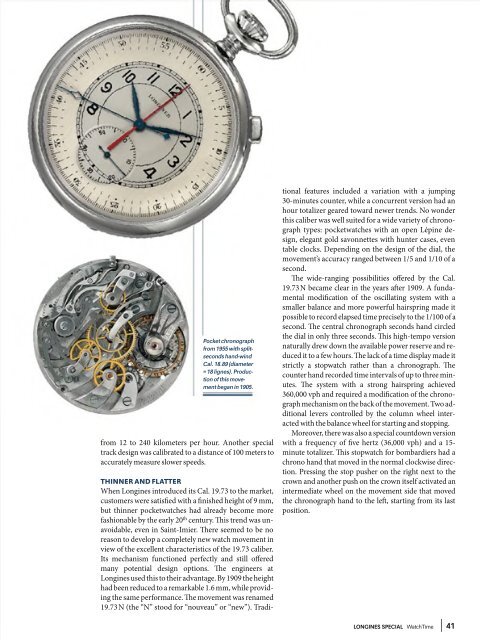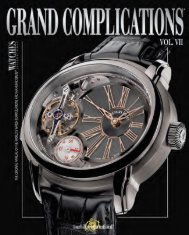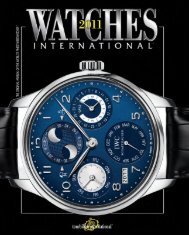180 YEARS OF
180 YEARS OF
180 YEARS OF
Create successful ePaper yourself
Turn your PDF publications into a flip-book with our unique Google optimized e-Paper software.
Pocket chronograph<br />
from 1955 with splitseconds<br />
hand-wind<br />
Cal. 18.89 (diameter<br />
= 18 lignes). Production<br />
of this movement<br />
began in 1905.<br />
from 12 to 240 kilometers per hour. Another special<br />
track design was calibrated to a distance of 100 meters to<br />
accurately measure slower speeds.<br />
THINNER AND FLATTER<br />
When Longines introduced its Cal. 19.73 to the market,<br />
customers were satised with a nished height of 9 mm,<br />
but thinner pocketwatches had already become more<br />
fashionable by the early 20 th century. is trend was unavoidable,<br />
even in Saint-Imier. ere seemed to be no<br />
reason to develop a completely new watch movement in<br />
view of the excellent characteristics of the 19.73 caliber.<br />
Its mechanism functioned perfectly and still oered<br />
many potential design options. e engineers at<br />
Longines used this to their advantage. By 1909 the height<br />
had been reduced to a remarkable 1.6 mm, while providing<br />
the same performance. e movement was renamed<br />
19.73N (the “N” stood for “nouveau” or “new”). Tradi-<br />
tional features included a variation with a jumping<br />
30-minutes counter, while a concurrent version had an<br />
hour totalizer geared toward newer trends. No wonder<br />
this caliber was well suited for a wide variety of chronograph<br />
types: pocketwatches with an open Lépine design,<br />
elegant gold savonnettes with hunter cases, even<br />
table clocks. Depending on the design of the dial, the<br />
movement’s accuracy ranged between 1/5 and 1/10 of a<br />
second.<br />
e wide-ranging possibilities oered by the Cal.<br />
19.73N became clear in the years aer 1909. A fundamental<br />
modication of the oscillating system with a<br />
smaller balance and more powerful hairspring made it<br />
possible to record elapsed time precisely to the 1/100 of a<br />
second. e central chronograph seconds hand circled<br />
the dial in only three seconds. is high-tempo version<br />
naturally drew down the available power reserve and reduced<br />
it to a few hours. e lack of a time display made it<br />
strictly a stopwatch rather than a chronograph. e<br />
counter hand recorded time intervals of up to three minutes.<br />
e system with a strong hairspring achieved<br />
360,000 vph and required a modication of the chronograph<br />
mechanism on the back of the movement. Two additional<br />
levers controlled by the column wheel interacted<br />
with the balance wheel for starting and stopping.<br />
Moreover, there was also a special countdown version<br />
with a frequency of ve hertz (36,000 vph) and a 15minute<br />
totalizer. is stopwatch for bombardiers had a<br />
chrono hand that moved in the normal clockwise direction.<br />
Pressing the stop pusher on the right next to the<br />
crown and another push on the crown itself activated an<br />
intermediate wheel on the movement side that moved<br />
the chronograph hand to the le, starting from its last<br />
position.<br />
LONGINES SPECIAL WatchTime | 41

















